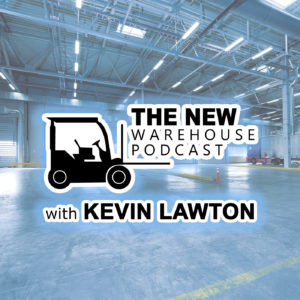 Kevin Lawton
Kevin Lawton Episode 58 – Raymond at MODEX 2020
Episode 58 – Raymond at MODEX 2020

The first in our series of interviews from this year’s MODEX, I am joined by Jack Kaumo of The Raymond Corporation. Jack is the Director of iWAREHOUSE Technology Solutions, Telematics, LMS, Automation, and Virtual Reality. Basically, he is the expert in all things technology that Raymond offers. We discuss The Raymond Corporation’s concept of optimizing before automating, which we first discussed in Episode 32 with CEO Michael Field, and how they have laid out these concepts in their MODEX booth. The discussion goes from virtual reality training to their iWAREHOUSE platform and then covering their automated products.
Virtual Reality
Definitely one of the coolest things at MODEX and one of the coolest things out there in our industry right now is Raymond’s virtual reality training platform. This platform allows companies to safely train and assess forklift operators without risks to people, property, or equipment. The virtual reality platform is incredibly realistic making the operator feel like they are actually operating the equipment. Myself and my intern Eric got a chance to try the virtual reality platform at the Raymond booth and we were both really impressed with how well it is put together and just how realistic it is. With comprehensive training courses, the platform allows for a very thorough training with grading that allows you to understand at what level the operator is and where they need to improve. If you get a chance to work with this platform or a chance for a demo I highly recommend it. You can see a video of the platform below.
Connect
The Raymond booth was set up displaying the optimize before automating in order of optimizing, connect, and then automate. The connect phase is through their multiple data connection points which include the iWAREHOUSE suite. Once you have begun to optimize, you then start to introduce these different technology points that allow you to gather important data regarding the use of your equipment. All of this collection is done through the iWAREHOUSE platform and ranges from equipment usage to safety checklist failures. With this data you can optimize your fleet by seeing what is not used as often and potentially swap those machines for machines that will be used more frequently. It also can allow for gaps in training with operators that may be failing checklists or that may have safety issues with impacts registering on their machines.
Semi-automated
On the path to automation, Raymond provides semi-automated solutions as well. Jack discusses their wire guidance that has a zoning and positioning component to it. Wire guidance allows for the forklift to be locked in so that the operator can only control the forward and backward direction of the machine with no ability to turn the machine. This allows the operator to be safer as they are traveling through the aisles and keeps them from potentially turning into the racking. With the zoning and positioning component, wire guidance is taken a step further. This will actually communicate with your WMS to determine where the next location is and take the operator to that next location through the fastest and most efficient route. It is essentially autopilot for your forklift and creates an incredibly safe environment where the concern of an operator making a miscalculated turn or maneuver is greatly reduced.
Time to Automate!
Once Raymond has helped you to optimize as much as possible then you are ready to explore their automation solutions. Raymond has been developing its automated offerings and has made great strides. Recently, they were recognized as a finalist for the International Intralogistics and Forklift Truck of the Year award for their 3030 Stacker which uses an industry-first Seegrid vision system. What is remarkable about this vision system is that it does not require any alteration to your infrastructure. As you hear Jack say in our discussion, this truck can be up and running with an assigned task in just one day. Really innovative and a big step in the right direction for implementing automation solutions.
Listen to our discussion below and let us know what you think in the comments.









